Special Operations Executive (SOE)
The Special Operations Executive or (SOE) was a British organisation formed in 1940 to conduct espionage, sabotage and reconnaissance in German-occupied Europe and to aid local resistance movements during World War II.
SOE personnel operated in all territories occupied or attacked by the Axis powers, except where demarcation lines were agreed upon with Britain's principal Allies, the United States and the Soviet Union. SOE made use of neutral territory on occasion, or made plans and preparations in case neutral countries were attacked by the Axis. The organisation directly employed or controlled more than 13,000 people, of whom 3,200 were women. Both men and women served as agents in Axis-occupied countries.
Scarce early WW2 RAF tunic brass button escape compass








These buttons were used early on during the war, when pilots and aircrew still wore their service dress tunics on Operational flights. This standard looking large button has a hidden compass inside. Ingeniously designed by Clayton Hutton and his team at MI9 this escape aid gave the airman a fighting chance to evade capture, if parachuted into enemy held territory. The compass is revealed by unscrewing the top half of the button, leaving the bottom half with the compass inside. This early example has a very fine right handed thread (later ones changed to a left hand) and the compass has a rotating disc to point North. Later escape compasses changed to a 'star' like pointer.
The button is 100% original wartime RAF issue. It is stamped on the reverse B'Ham Buttons Ltd. together with Trade Mark and a pair of cross swords.
WW2 RAF SOE Escape & Evasion Buckle Compass






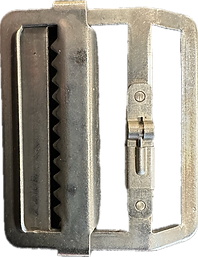
This is a rather ingenuously designed escape aid compass. Designed and produced by the escape aids team at MI9, headed by the famous Clayton Hutton. It takes the form of a rather innocuous buckle that would have been found on almost all RAF, suits aircrew blouses, war service dress blouses, and standard battledress blouses. When worn the actual compass part was not even visible. A fantastic design, that was almost impossible to detect by German guards etc. The buckle had a sliding collar that when moved would release a compass pointer, and on the other side a small pin could be lifted up and the compass pointer placed on top, producing a perfectly working and concealable compass.
A good condition example of this battledress and aircrew blouse buckle escape compass. Complete with the sliding collar, compass pointer, and pin. All of the components are in excellent condition, most probably never worn or used. The buckle still retains all its plated finish, and the compass pointer and pin are all in good condition, without any damages or issues. The compass itself also still working when compared to my phone compass, pointing north once given a small tap.
WW2 Fairbairn Sykes 2nd Pattern Fighting Knife 'The F-S Fighting Knife"
with Wilkinson Sword logo





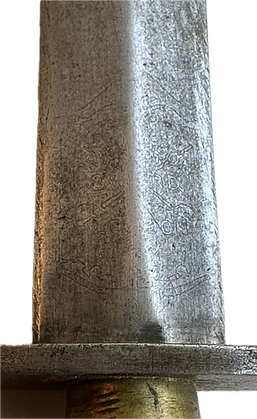


This is an original WW2 Fairbairn Sykes 2nd Pattern Fighting Knife,
made by Wilkinson. This example is sought after with the etched blade reading 'The F-S Fighting Knife" on one side and the Wilkinson logo on the other, which although very feint is still visible. The 2nd Pattern F-S knife featured a finely knurled brass hilt, thick steel cross guard, doing way with the earlier square ricasso of the 1st pattern. This knife has its original leather scabbard which, as was common of the period, has had its 4 tabs and retaining elastic strap removed. authentic 2nd Pattern WW2 British commando knife that looks to have seen active service.
MI9 escape compass Pencil clip & Wartime stationary office pencil





This is one of MI9 and Christopher Clayton Hutton's escape compass designs, using a simple metal pencil clip. This makes it very inconspicuous for the enemy to identify as an escape item. These clips are magnetised and have a small indentation punched into the back of the clip in the centre, allowing it to be placed on the tip of a pencil or nail. This allows the clip to point North.
This rare escape compass clip with a wartime stationary office pencil, both excellent condition
Veterans original Bullion SAS Blazer badge



Nice orginal Bullion SAS blazer badge, from a named veteran to L/CPL J. G. Jowett, service no. 410303 R.Sigs/SAS, Signals Squadron, this was acquired from a dealer who puchased a grouping from the family. Good used condition.
Scarce WW2 Macleans Dentifrice with Concealed Escape Compass


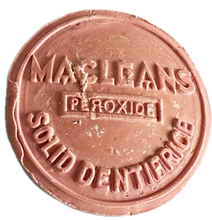



This is a scarce WW2 Macleans Dentifrice with Concealed Escape Compass.
On the surface this is simply just a tin of Macleans peroxide solid dentifrice. However cunningly concealed within the cake of dentifrice is a standard RAF escape compass. The compass is revealed after removing the protective cellophane and looking at the bottom - some of the dentrifice has been scrapped away to reveal the compass hidden within. Extremely hard to find SOE item.
WW2 RAF SOE Escape miniature telescope MI9





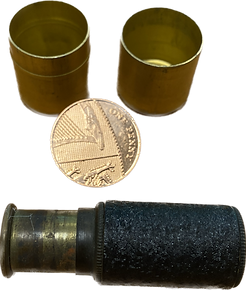
The British one pence "1p" coin really gives you an idea of the size of this telescope.



Very nice example of a genuine WW2 single drawer Miniature escape Telescope. The main body has a black rough textured finish. Complete with its original aluminium container with most of its gold coating remaining.
extremely hard to find in this condition.
Developed by Clayton Hutton at MI9 to aid in both evasion and escape know as SOE.
It measures 3cm long when closed, 4.3 cm long with single drawer extended.
The lenses are very clear and give a good viewing image, the brass body is in a good condition, overall excellent good condition, rough textured finish intact.
MI9 "The British Directorate of Military Intelligence Section 9".
This was a highly secret department of the War Office between 1939 and 1945.
SOE “Special Operations Executive”.
In June 1940, a new volunteer force - the Special Operations Executive (SOE) - was set up to wage a secret war. Its agents were mainly tasked with sabotage and subversion behind enemy lines, real-life inspirations for James Bond.
Scarce WW2 SOE smoking pipe with concealed dagger
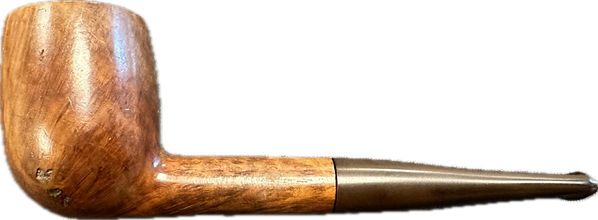









WW2 Special Operations Executive (SOE), These were carried by agents, having a concealed fullered blade which can be used as a weapon or even an escape tool if captured, but also can still be smoked like a normal pipe. This has the brass inner joint to stop the heat conducting down to the blade to the mouth piece. Top of the stem near the bowel is marked 23. This one has been lightly used and is in great condition.
Scarce WW2 SOE Clandestine Assassin Spike/Dagger cutaway Pencil






A rare and lethal agent's weapon, manufactured by MI9 and distributed initially to SOE agents in the field and later to American OSS agents. A somewhat unassuming object, easily carried on the person, but which revealed a surprising lethal spike, and fatal at close quarters. This is a cutaway assassins spike concealed within a pencil, Probably used as for demonstration for Special Operations Executive (SOE) operatives. The pencil has three notches cut out to reveal the lethal fluted blade secreted inside. There is a length of wind wrapped around the blade. The pencil is marked Eagle Pencil Co War Drawing.
complete set of WW2 British Acetone Celluloid Delay Action fuze
ampoules in original box





The A.C. delay fuze was used with the limpet mines that was used with black-ops operations by SOE members, OSS members and commando troops.
The colour of the ampoule defines the time that the fuze is activated.
With a temperature of 5 degrees:
-red takes 6 ½ hours
-orange takes 9 ½ hours
-yellow takes 20 hours
-green takes 34 hours
-Clear/blue takes 67 hours
-violet takes 8 ½ days
The ampoule of choice is placed in the fuze and then the fuze is closed, This breaks the ampoule and the acetone will act with the strike pin spring.
When it will actually be activated is defined with the colour ampoule of choice.
Each ampoule has a paint dot on it, so no mistake can be made about the colour if you are colour-blind)
WW2 SOE/Special Forces Switch No.4 igniter




Switch No.4 ( Type 6 Pull Switch ). Widely used igniter by both SOE and Special forces employing a simple striker mechanism triggered by pulling on the rear loop. Switch has swivelling mounting bracket which enables it to be used with a tripwire and comes with a screw in spring snout to receive safety fuze. Good, clean condition.
WW2 MD1 SOE Pull Switch igniter No.1






Original WW2 S.O.E / booby trap device. It is made of brass with sprung detonator at one end. Initially known only as the "Pull Switch" this device was designed near the end of 1939 by Lt. Col. Stuart Macrae of MD1 (Military Department 1) He’s best known for inventing the sticky bomb. It came about because the only device the British had to set off a boobytrap with a trip wire was the standard service igniter, a device actually designed to replace matches for lighting a length of safety fuze. The service igniter worked perfectly well for the purpose it was designed but left something to be desired as a boobytrap device. It is in very good condition and measures 5 inches long.
WW2 Escape and Evasion 1943 Shaving Brush and Hidden Compass





WW2 Escape and Evasion SOE “Special Operations Executive” Shaving Brush and Hidden Compass 1943 dated, brown bakelite shaving brush containing an MI9 escape compass.
On the base of the brush there is a war department arrow and the manufacturers name - lenc, plus a 1943 date. Unscrewing this base from the brush, reveals an escape compass fixed into it. Originally, this would have had a shaving soap stick covering, so concealing it.
The brush is in a very good used condition.
WW2, RAF & SOE issued, silk 'blood' or 'ghoolie' Chit





WW2, RAF & SOE issued, silk 'blood' or 'ghoolie' Chit.
Used to help during an escape & evasion attempt, in the Indian/Asian theatre, if captured by 'friendly' civilians etc....Printed in 17 different languages. Size, 19 x 11 inches.
In a very good condition
Scarce WW2 British SOE Folding locking Jack Knife

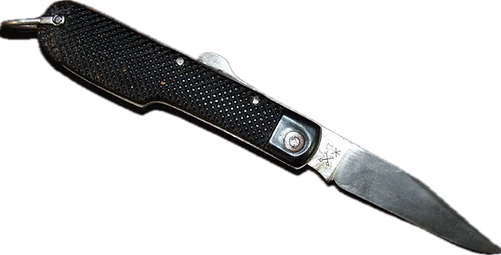





A scarce WW2 British Commando & S.O.E. Lock knife. These knives were manufactured in England primarily used by Commando’s & the S.O.E. These knives can be seen in the following references: 'British and Commonwealth Military Knives' by Ron Flook, Secret Agents Handbook of Special Devices by Mark Seaman and The British Spy Manuel by the Imperial War Museum. There are two variants of these knives one has the Tyre-cutter blade at the opposite end of the knife, this one is without.
Manufacturer is 'JOHN NOWILL & SON'S SHEFFIELD stamped on the blade. The knife is fitted with correct steel lanyard ring. The single edged blade measures 3 1/4” long and it is 8” overall with the blade locked out. The blade folds out and locks in place correctly. Once extended the blade is locked in place and released by pressing the catch on the top of the handle. Grips are in black plastic terminating with a folding D ring to allow the Knife to be attached to a lanyard.
there is a small split in the plastic from one side of the grips whilst the other side shows evidence of maybe heat, but solid and a honest Lock Knife in very used condition.
RAF shirt collar stud escape compass and Air Ministry collar.




These special collar stud compasses are half the depth of the standard half inch MI9 escape compass. This was to give the collar stud the exact same appearance as a regular one, also the front glass was painted white. When required for use the paint was simply scratched off. Clayton Hutton at MI9 had these compasses specially manufactured purely for the collar stud.
This example is in a very good working condition. There is some slight trace of the white paint on the glass edge. It is the early type compass with a rotating disc, rather than the later star type pointer. with an original wartime issue RAF shirt collar
Rare WW2 SOE Escape and Evasion Toothbrush hidden escape compass









This is a very rare WW2 SOE “Special Operations Executive” Escape and Evasion Toothbrush with hidden escape compass, this one is complete with its concealed compartment, cover and holding ring, would be very difficult to find in this superb used condition. Extremely hard to find.
Rare RAF/SOE MI9 pattern escape and evasion lighter compass







This escape and evasion lighter, 'Swinger, Type No.16' as issued to some aircrews. Designed by Christopher Clayton Hutton and his team at MI9, at first it appears to be just a simple but very robust cylindrical lighter. It has a screw top lid secured to the body via a short chain to avoid loss. Beneath this is a short section of wick and a standard friction roller mechanism used to create a spark to light it. The base of the lighter can be unscrewed to reveal the chamber for the wadding to which the fuel was added, and a tiny knurled screw within a centrally positioned cylinder at the top of the base can be undone to reveal space for spare flints. What isn't obvious is that the entire top of the base can be unscrewed via a reverse thread, revealing a hidden standard 0.5" MI9 pattern compass. The incredibly ingenious MI9 lighter is one of the rarest as production numbers were relatively low. A rare piece in superb condition.
WW2 RAF / SOE escape & evasion 'fly' button compass, type 6



A pair of brass fly buttons as used on R.A.F. and other British Forces battledress trousers etc. Designed by Christopher Clayton Hutton at MI9 and designated as the 'Swinger, Type No.6', one button has a small 'spike' in the centre on which the second magnetised button can be balanced. Small luminous dots on this button indicate North & South. Issued to aircrews to aid escape and evasion. This example is in mint unused condition, still attached to the card it was supplied on.
WW2 RAF / SOE micro escape & evasion compass



These compasses were Developed by Christopher Clayton Hutton at MI9, this is the final design of the miniature escape compass and the smallest measuring just 5mm in diameter and 2mm tall. The case is solid brass and fitted with a central 'pin' onto which the rotor is placed. This is in the form of a simple black painted metal disc marked with a single luminous dot to indicate North. Being so tiny this compass could easily be concealed inside such things as pencils, pens, pipes, cigarettes etc. It would no doubt have been incredibly challenging to use but is now one of the rarest compasses to find. In very good used condition.
WW2 RAF escape & evasion razor blade


RAF issued, razor blade compass, War Department broad arrow marked.
The blade has been magnetized so that when its suspended by a thread in water it can be used as a compass. This makes it ideal for Escape and Evasion purposes.
Other, different brands of blades were issued including, Cheerio and Dawn.
This is in a unissued condition, It is still showing some signs that magnetism is present, seen when moved next to a compass.
WW2 RAF 'Beadon' flying suit knife






Issued as part of the Beadon Flying Suit (Lightweight Flying Overall) and the Tropical Survival Kit these simple folded sheet steel bodied clasp knives were given the R.A.F. Stores Reference 22P/11. Fitted with two blades - one simple 9.75cm standard single edged spear-point blade and a similar length non-edged spike with an overall blued finish. Comes in good used condition with most blued finish now worn with the exception of the spike which retains nearly all its original finish.
WW2 Merlin Sub Miniature SOE Spy Camera c1936

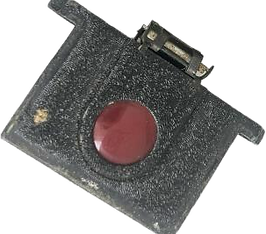



Merlin Sub Miniature Spy Camera c1936, A rare example of a miniature spy camera as used by British S.O.E (Special Operations Executive) agents behind enemy lines during WW2.
WW2 RAF escape and evasion compass in waterproof pouch



RAF escape and evasion miniature compass, still sealed in it's original waterproof pouch. Air ministry stores reference number, 22P/15.
The compass measures 15mm in diameter. The compass spinner moves freely and it's condition is excellent. The waterproof pouch is in original sealed condition and is still clear. The white cotton tape lanyard is in very good condition with only a couple of storage marks. Part of the RAF wartime escape and survival equipment.
These were issued to RAF aircrew to be carried in escape kits or sewn into uniforms etc, they were also issued to SOE operatives. There are no markings on these just incase the solider was captured by the enemy.
During World War Two, the Department 9 of the British Directorate of Military Intelligence (M.I.9 - Escaped British Prisoners of War/POW, Debriefing, Escape and Evasion) developed a great number of secret means to conceal tools and instruments in harmless looking objects for everyday use. The means the pilots carried with them during the air raid were called pre-capture. These comprised many items like uniforms or shoes, that could easily be converted in civilian plain clothes but also see saws, food, etc.
Compass 1
Compass, M.I.9. pattern, wrapped in transparent waterproof material. Stores ref. 22P/15. Comprises a standard 0.5" escape compass with 'star' rotor encased in a small plastic pouch to seal against humidity. Could be used by an evading or escaping airman to head for neutral territory. Issued with many escape packs/kits. Some light soiling but in good working condition overall.


Compass 2
Small compass in the form of a pointed, metal bar. Chemically blackened finish with minor wear. Central hole with white and red dot markings. Measures 27 mm long. This form of compass is designed to be suspended from a piece of cotton and would spin until pointing North. To avoid vibration and any wind movement it could be suspended in a glass of water to give a damping effect!


Compass 3
RAF black bakelite battle dress escape button compass.
This bakelite button was designed by the team at MI9, to be sewn onto a battle dress blouse or trousers and look exactly the same as the standard buttons. When removed it could be placed in water or suspended by a thread (as this example) to show North. Two illuminous dots point North and one for South.


Compass 4
WW2 British Airborne Battledress Blouse Epaulette Button Escape Compass
Three dots are located on the back surface adjacent to the rim if the button, so they could not be seen when sewn onto the uniform. The single dot which is on the side of the periphery opposite from the two closely spaced dots points toward the Magnetic North. The compass element is a small magnetised bar of steel which has been embedded in the plastic body during the moulding process. In use, the button is suspended from a fine thread about 12” (30,5 cm) in length and is allowed to oscillate until it comes to rest.


Compass 5
A Small compass with brass case and glass top. Chemically blackened finish with minor wear. Inside with 4 pointed star shaped pointer with white and red dot markings. Measures 15 mm diameter and 5 mm deep. Working order.


Compass 6
A Small compass with brass case and glass top. traces of a Chemically blackened finish. Inside with rotating pointer and dial marked NESW. Measures 10 mm diameter and 3 - 4 mm deep. Working order. The smaller than normal size suggests it was for concealing inside a uniform button.

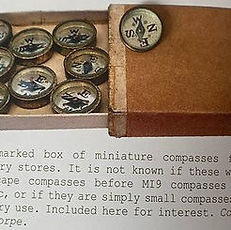
Compass 7
A Small compass with brass case and glass top. Inside with printed dial with arrow to point North. Measures 17 mm diameter and 5 mm deep. Working order.

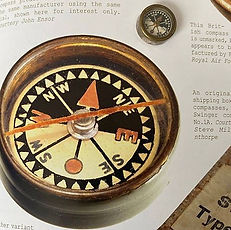
Compass 8
"GS" General Service button hanging from a piece of string/cotton the crown on the button points to North, Working order.


WW2 RAF Escape and Evasion kit sealed matches





The matches are still sealed in their waterproof celluloid plastic cover, marked at the bottom 'contains 20 matches'. Size, 6.5 x 4 cm. They have a stores Ref. No. 12D/761.
ORIGINAL WW2 RAF AIR MINISTRY NO (7329A) 1941 ESCAPE EVASION SILK MAP FRANCE / GERMANY 9C A. (MOST SECRET)




Air Ministry double-sided silk escape map carried by RAF personnel. These were also widely used by USAAF crews and pilots.
One side covers France, Ref 7329 A / 9C (a) dated 1941, and is printed in three colours. The other side covers Germany, (MOST SECRET) ref: 7330 / 9U R, and is printed in two colours.
This is one of the earliest escape map published by the British military intelligence unit (MI9) in 1941. It shows Escape routes the border between French occupied and unoccupied zones, also coastal defences etc. Excellent condition.





WW2 Kleen British Escape And Evade Razor Blades 1944




4 X Kleen British WW2 Escape And Evade Razor Blades. Manufactured by Kleen and Clearly 1944 Dated.
The Razor Blade is Broad Arrow Marked on the Side that Would have been Magnetised. When Placed on Water, it Would Float Then Slowly Turning the Razor Blade Pointing The Arrows to the North.
WW2, RAF Emergency ration tin still sealed with contents





WW2, RAF emergency ration tin still sealed with contents.
Found in dinghy survival kits, etc. This ration tin would have also been issued to the army and special forces. The tin is in a good condition, although some of the bright plated finish is now missing, which is often the case with these tins. The securing band is still in place, Good to find still with the original contents
British, WW2, SOE and Commando Booby Trap Switch Number 3,
Release, Mark 1 Booby Trap Switch




This is a British, WW2, Special Operations Executive and Commando booby trap pressure switch used for detonating explosives by means of a percussion cap or a blank cartridge. Booby trap mechanisms were developed by ‘Experimental Station 6’ which was a cover name for the SOE (Special Operations Executive).
This is a Switch Number 3, Release, Mark 1 switch and is made of green painted steel and has a spring loaded hammer with an anvil for detonating a primer. The switch was designed by Lt. Col. Stuart Macrae.
Superb Condition 1944 Broad Arrow Army WW2 Escape Axe
Elwell 27N/1 RAF Aircraft


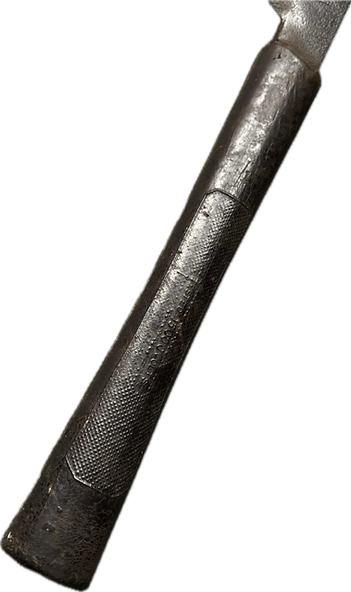

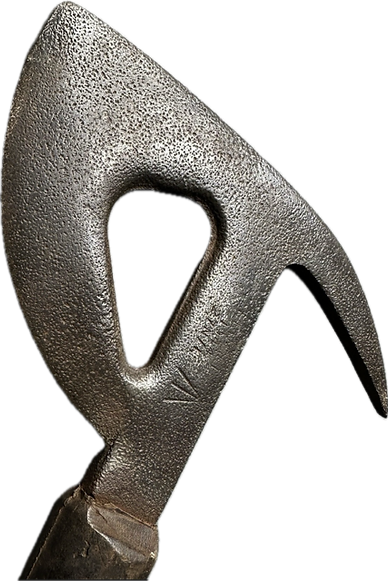

Superb Condition 1944 Broad Arrow Army WW2 Escape Axe, markings 27N/1 RAF Aircraft, the rubber handle is excellent no damage which is rare. Becoming hard to find in this condition
RAF Beadon flying suit survival matches and container.



This aluminium screw top container is fully waterproof.
It contains the special large-head, long burning type of matches, inside the inner pull-off cylinder.
The inside of the outer container holds the match striker.
Air ministry transfer type label on the outside, with Air Ministry Ref. No. 12D/460 (scratched). The container Size = 2 ½ x 1 ½ inch.
RAF escape & survival kit matches card



A scarce printed card matchbox with a large V for victory !
On the base fold it states, 20 matches, made in Canada, A scarce item.
